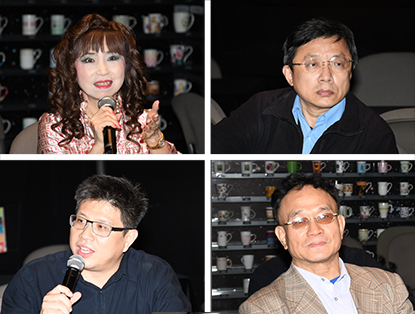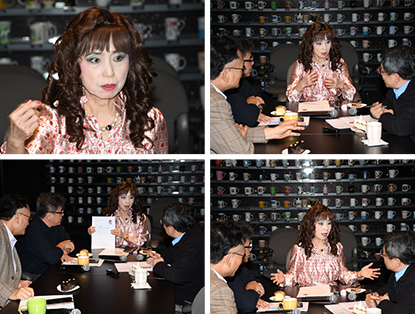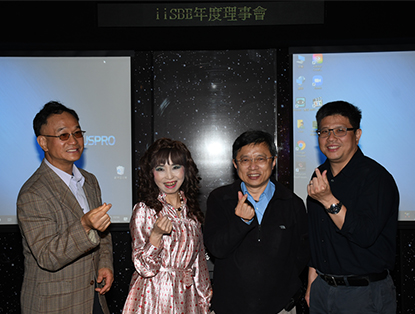iiSBE Zoom Board MeetingDate: 2021-04-14
Section: Exchanges |  本會長期贊助台灣永續建築環境促進會,推動台灣永續建築與共生環境之發展,並積極參與國際組織舉辦的各項交流活動,闡揚共生文明理念。iiSBE總會於2021年3月29日舉辦年度理事會ZOOM會議,本會黃晉英秘書長、台灣永續建築環境促進會王文安理事長、李彥頤秘書長及蕭睿麟會員特別出席參與會議,期能讓國際友人感受到,即使面對COVID-19疫情威脅,台灣仍能積極推動永續建築與共生環境之發展,更提出Taiwan Can Help的呼籲,希望能為國際社會作出更多貢獻。 本會長期贊助台灣永續建築環境促進會,推動台灣永續建築與共生環境之發展,並積極參與國際組織舉辦的各項交流活動,闡揚共生文明理念。iiSBE總會於2021年3月29日舉辦年度理事會ZOOM會議,本會黃晉英秘書長、台灣永續建築環境促進會王文安理事長、李彥頤秘書長及蕭睿麟會員特別出席參與會議,期能讓國際友人感受到,即使面對COVID-19疫情威脅,台灣仍能積極推動永續建築與共生環境之發展,更提出Taiwan Can Help的呼籲,希望能為國際社會作出更多貢獻。
The Archilife Research Foundation (ARF) has long been sponsoring the Taiwan Society of Sustainable Built Environment (TSSBE) in promoting Taiwan’s sustainable building development and its symbiotic environment. The TSSBE has also actively participated in various exchange activities organized by international organizations to advocate the concept of symbiotic civilization. The International Initiative for a Sustainable Built Environment (iiSBE) held the annual Zoom Board Meeting on March 29, 2021. ARF Secretary General Huang Chin-ying, TSSBE Chairman Wang Wen-an, Secretary General Li Yen-yi, and member Hsiao Jui-lin specially attended the meeting, hoping that our international friends will see how Taiwan manages to actively promote sustainable buildings and the symbiotic environment despite the threat of the COVID-19 pandemic. The Taiwan Can Help appeal has also been proposed in the hope of contributing to the international society.
 本年度理事會由iiSBE總會Nils Larsson執行長主持。會議報告與討論重點包括:2021年至2023年SBE地區會議,將陸續於布拉格、柏林、蒙特利爾等地召開;未來將持續開發iiSBE工具,並與各地區分會積極合作,共同推動與iiSBE工具相關培訓、研討會和教育工作;邀請各地區分會代表人擔任理事,共同參與iiSBE總會的會務運作;iiSBE總會的網站將進行改版,規劃增列會員專長,期能強化會員之間的連結與交流。 本年度理事會由iiSBE總會Nils Larsson執行長主持。會議報告與討論重點包括:2021年至2023年SBE地區會議,將陸續於布拉格、柏林、蒙特利爾等地召開;未來將持續開發iiSBE工具,並與各地區分會積極合作,共同推動與iiSBE工具相關培訓、研討會和教育工作;邀請各地區分會代表人擔任理事,共同參與iiSBE總會的會務運作;iiSBE總會的網站將進行改版,規劃增列會員專長,期能強化會員之間的連結與交流。
This year’s board meeting was hosted by iiSBE CEO Nils Larsson. The meeting report and discussion focuses include: SBE regional meetings from 2021 to 2023, which will be successively held in Prague, Berlin, Montreal, among others. In the future, iiSBE tools will continue to be developed. The chapters in different regions also actively cooperated in jointly promoting iiSBE tool related trainings, seminars, and education. The representatives from the chapters in different regions were invited to serve as directors and jointly take part in iiSBE affairs. The iiSBE website revision will be carried out, with the members’ specialties planned and listed, hoping to strengthen links and exchanges among the members.
 黃晉英秘書長於發言時,特別向iiSBE總會Nils Larsson執行長表達,台灣永續建築環境促進會非常樂意擔任理事的職務,除共同推動iiSBE總會的會務運作之外,更能與所有會員分享台灣在永續建築與共生環境領域中,長期推動相關學術研究與實務所獲致的豐碩成果。此外,台灣永續建築環境促進會的網站,已經羅列每位會員的學歷、經歷、重要職務、個人專長、參與活動等,相信能作為iiSBE總會網站改版最佳參考範例。Nils Larsson執行長亦對黃晉英秘書長的熱情回應表達衷心感謝。 黃晉英秘書長於發言時,特別向iiSBE總會Nils Larsson執行長表達,台灣永續建築環境促進會非常樂意擔任理事的職務,除共同推動iiSBE總會的會務運作之外,更能與所有會員分享台灣在永續建築與共生環境領域中,長期推動相關學術研究與實務所獲致的豐碩成果。此外,台灣永續建築環境促進會的網站,已經羅列每位會員的學歷、經歷、重要職務、個人專長、參與活動等,相信能作為iiSBE總會網站改版最佳參考範例。Nils Larsson執行長亦對黃晉英秘書長的熱情回應表達衷心感謝。
While speaking, ARF Secretary General Huang Chin-ying specially expressed to iiSBE CEO Nils Larsson that the TSSBE takes pleasure in serving as a director. In addition to jointly promoting the iiSBE affairs, the fruitful results yielded from the long-term promotion of relevant academic research and practice in the field of Taiwan’s sustainable buildings and symbiotic environment were also shared with all the members. Furthermore, the education backgrounds, experiences, major posts, personal specialties, and activities of every member are listed on TSSBE’s website, which shall serve as the best examples during iiSBE’s website revision. iiSBE CEO Nils Larsson also positively responded and expressed his heartfelt appreciation.
 本次理事會結束後,黃晉英秘書長特別提示與會人員,因為台灣的防疫成效非常卓越,使得台灣的能見度與影響力大幅提升,我們應該善用此機運,積極參與各項國際交流活動,推動共生化與數位化的進展,導引人類族群邁向共生文明的未來。最後,黃晉英秘書長再次感謝與會人員的參與,並邀請與會人員合影留念,為本次的iiSBE年度理事會,劃下完美的句點。 本次理事會結束後,黃晉英秘書長特別提示與會人員,因為台灣的防疫成效非常卓越,使得台灣的能見度與影響力大幅提升,我們應該善用此機運,積極參與各項國際交流活動,推動共生化與數位化的進展,導引人類族群邁向共生文明的未來。最後,黃晉英秘書長再次感謝與會人員的參與,並邀請與會人員合影留念,為本次的iiSBE年度理事會,劃下完美的句點。
At the end of the board meeting, ARF Secretary General Huang Chin-ying suggested to the participants that the substantial increase in Taiwan’s visibility and influence is the result of Taiwan’s excellent pandemic prevention effectiveness. We should take this chance to actively take part in various international exchange activities, promote symbiotic and digital progress, and lead mankind toward the future of symbiotic civilization. Lastly, ARF Secretary General Huang Chin-ying thanked all the participants again for their participation and invited them to take group photographs for remembrance as the iiSBE annual board meeting came to a successful close.
|
|